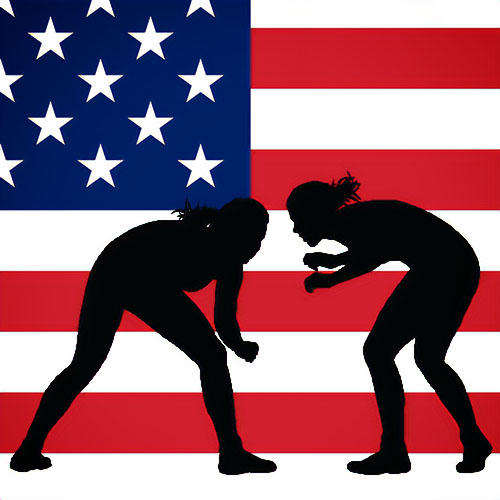Fame and fortune, she said, are all she wanted from the world. She got what she wanted, and the world, too ... for a very long time.
Madonna
It was exactly two years ago this month that Penthouse published its first sensational portfolio of Madonna photographs. At the time, her fame, immense as it was, still bore the blush of its bloom. In little more than the span of four seasons, she had gone from being Madonna Louise Veronica Ciccone, formerly of Bay City, Michigan-cute, unknown, scuffling — to being simply and spectacularly and sublimely Madonna, the sweetheart and sex goddess of the Western, and the Eastern, world.
It was her fate, her destiny, her luck, her fortune cookie from the Big Chinese Waiter whose name and the wind over Weehawken are one. The world was ready for it. More than that, the world was ravenous for it: the return of the blonde goddess, the renewed snap of the great magical garter more powerful than a thousand E.R.A.’s barreling headlong down the vast sexless water slide of Judeo-Christianity. The world was ready for it, the appetite was there; and she was there, bless her, to give it what it wanted. But she proved herself to be much more than just a phosphorescent flash of platinum-blond body heat. She and the world-it was not merely a matter of a quick fuck between them. It was a ring through the nose and a blown kiss, the beginnings of a liaison that has just gotten hotter and hotter with the passing of time.
“There are about a million opposites living inside of me,” Madonna once said. In the two years since Penthouse showed her as the world had never seen her, more than a few of those opposites have come to light. Divine Monroe reborn, peepshow floozy, suffering grisette in gingham, virgin and whore, little girl and bride, saint and man-eater, angel and sinner she has swept through all these guises and more. At times, it has seemed that she is nothing more than a series of masks illuminated from behind; and it has been the mercurial mystery of that elusive radiance behind the masks that has captivated. Unknowable — if, indeed, there is anything to know she enthralls, in a way that flesh in the hand never could. The true heart of her talent, the true heart of her gift, may be just that: She illuminates masks well. She gives good light.
Her last album, True Blue, released in July 1986, surpassed its predecessor, Like a Virgin, in international sales. This was no meager feat, as Like a Virgin had yielded three immense single hits (“Material Girl,” “Into the Groove,” and the title cut) and risen to No. 1 in nine countries, earning Madonna more than $8 million in royalties. True Blue was dedicated “to my husband, the coolest guy in the universe.”
That husband, of course, is Sean Penn, whom she had married on August 16, 1985, her 26th birthday. This petulant and pugnacious young method actor, two years her junior and a minor player in the bread-winning scenario, distinguished himself by consummately playing an asshole onscreen, and even more consummately off-screen. Perhaps as disliked by the lowly public as Madonna has been adored, her marriage to him tested that adoration. Marriage, it appears, tends to deflate the stock of a sex symbol. It is an infidelity to the adorer-an adultery to the males, an abandonment to the females, an irrevocable symbolic rending of a maidenhead and bond that lived in illusion if not in fact. Of course, if an icon must marry, it is better, image wise, that it marry another icon — a Joltin’ Joe for Marilyn, or, in the bargain basement, a Brigitte Nielsen for Sylvester Stallone. Madonna’s choice was thus not only baffling, it was dangerous. That she survived this test, stock unhurt and adoration unflagged, is a tribute to her sovereignty. That she remained unscathed after calling him “the coolest guy in the universe” was more than a tribute; it was perhaps a tiny miracle — or, at the very least, testimony to the fact that, as far as sex symbols are concerned, a little stupidity worn on the sleeve can be just as attractive as a little beauty spot worn on the face.
In any event, the public drew the line at the cinematic pairing of the two. With The Falcon and the Snowman to his credit, Penn is perhaps the most famous graduate of that group of youthful emoters called the Brat Pack. Madonna had been in a few pictures herself. In 1980, while still unknown, she had been in an hour-long skin drama by Stephen Lewicki. Called A Certain Sacrifice, it had been distributed only sub rosa. There was a small role in Vision Quest a few years later; then, in 1985, her big part in Susan Seidelman’s Desperately Seeking Susan. (Coproducer Sarah Pillsbury-right on the doughboy money-said she saw in Madonna a “punk Mae West” who was a “total fantasy for both men and women.”) Though she won wide praise for her work in Desperately Seeking Susan, praise was a credential Madonna no longer needed. By now, she was a goddess. Publicists, envisioning the possibilities of her and Penn together on-screen, gushingly invoked Lombard and Montgomery, Bacall and Bogart. In fact, “this film doesn’t need publicity,” Penn himself said upon firing unit-publicist Chris Nixon during production. “The people will go to see it because we’re in it.”
The film was Shanghai Surprise, produced by ex-Beatie George Harrison and directed by Jim Goddard, best known for his British television series “Reilly: Ace of Spies.” In Shanghai Surprise, Madonna played a prim missionary named Miss Tatlock, who spreads her legs for Penn and the cause of righteousness in pre-World War II China. Penn was right. The picture did not need publicity. It needed an act of God. And he was wrong, too. The people did not go to see it. The publicists’ dreams of Lombard and Montgomery, Bacall and Bogart, gave way to the realities of Tedium and Blunder. United Press International described Shanghai Surprise most succinctly — a “complete critical and commercial failure.”
Madonna emerged from the fiasco unruffled, proving yet again that she was beyond destruction. “The director,” she said, “just had no idea of what he was doing.” The memory of the fiasco was washed away by the waves of her next hit, “Papa Don’t Preach.” It was a song about an unwed mother-to-be that even Tipper Gore, founder of the crypto-chaste Parents Music Resource Center, praised for its “sense of urgency and sensitivity.”
Her next movie role was to have been in the Tri-Star production of Blind Date. She withdrew from that deal in the summer of 1986, when she found that the studio had hired Bruce Willis to play opposite her despite the fact that she had been promised approval of the male lead and director. The role went to Kim Basinger. Similarly, a talked-about production of Evita was abandoned. Instead, Madonna took a part that summer in the limited-run Lincoln Center production of David Rabe’s play Goose and Tomtom. Meanwhile, her new album, True Blue, blossomed predictably.
She accepted the role of Nikki Finn, a darling parolee searching to discover who framed her for murder, in the Warner production of James Foley ’s Who’s That Girl (called Slammer originally). Foley, who directed two of her videos-”Papa Don’t Preach” and the European version of “True Blue”-as well as At Close Range, in which her husband starred, is described by her as “a genius.”
Now, once again, the day is hers. Her sold-out world tour, begun this past June in Japan, Who’s That Girl, and her fourth album have claimed it for her. Fame and fortune, she has said, are what she wanted from life. If there was ever any doubt in the last few years, there is none today. Madonna, barely 28 this August and at her zenith, has exactly what she wanted.
The pictures these words accompany — the last of the Madonna nudes, pictures the world has never seen before — are from a time not so long ago, but yet a time difficult to imagine: a time before having a last name was unimportant, before there was a Madonna who had the whole world and all she wanted from it.
There really seem to be no masks in these pictures. That is their simple charm. They seem to capture the look, young and hungry and enamored and almost guileless, that served as the mold for the mask of charm, one of many, that the world would come to know. But, of course, these are more than just portraits of a girl on the verge of something bigger than she dared to dream. They show that their subject’s credentials as a budding sex goddess consisted of much more than a well-placed beauty mark and a well-practiced lowering of the eyelids. Her hair still dark rather than blond, her expression one of purity rather than of beaute du diable, her dancer’s body still angular and bony rather than voluptuous.
In these amateur photos, she was something that she could never be again. Seeing her posed in oversized cowboy boots, Lash LaRue neckerchief, and hat is like glimpsing the awkward little girl inside the bigger-than-life star that became the world’s virgin whore.
It is unlikely that the world will ever see Madonna like this again. “I’m at a stage in my career where any kind of nudity would be an incredible distraction within a given movie,” she recently explained to American Film magazine, adding, “I was disturbed by the nudity in Blue Velvet.” Furthermore, “I had a traditional Catholic upbringing.”
At this point in time, Madonna has become a vast multimillion-dollar industry unto herself. She has her own development company, Siren Films, which, among other projects, is presently involved in an adaptation for her of the French writer director Agnes Varda’s 1962 melodrama, Cleo de 5 a 7. At the same time, Diane Keaton and producer Joe Kelly at Fox are revamping the 1930 Josef von Sternberg-Marlene Dietrich classic, The Blue Angel, for her. In Great Britain, Feldon Productions has built an entire publishing business around her with incredible success churning out not only books and magazines with titles such as 101 Things You Never Knew About Madonna (“She Lives to Tell: Of Loves and Romance, Winning Hearts and Stealing Men!”}, Madonna-Style and Fashion, and Madonna in Quotes, but also the Official Madonna Jigsaw Puzzle and the Fantastic Madonna Treasure Kit (“Where else could you get a silky Madonna scarf, three bright button badges, a see-thru keyring, two eight-inch stickers, and three postcards?” Where else, indeed?).
Madonna is comfortable with her own stardom and, more significantly, with all of the attendant mythology that goes with it. She even has her favorite stories: “that I have a shrine to Marilyn in my bedroom, that I believe the spirit of Elvis is inside my soul, and that I lost 14 pounds on a popcorn diet.”
Has her ever-increasing success changed her? No, her nine brothers and sisters say; for, as Madonna herself explains, “I always thought that I should be treated like a star.” Has it affected her family? Sort of. “They ask to borrow more money,” she says.
There is no telling, of course, in this moment of her greatest fame, what the next few seasons and years will bring. Twelve months from now, she will be entering her 30th year. That is a dangerous time for sex goddesses. Already, there are rumors-started, it seems, by her hairstylist at the Bumble and Bumble salon on East 56th Street in Manhattan-that her hair has begun to fall out alarmingly, due to the heavy bleachings of recent years. Others speak of the ugly sagging holes, three in each earlobe, that have started to gape from the weight of too much gaudy Jewelry worn for too long; and they speak, too, of little wrinkles at the corners of the eyes and the lips. And it is no big secret that her two-year-old marriage-made-in-heaven has withered back to earth.
But those who contemplate such matters would be far better off counting the hair clumps in their own combs. By now, Madonna has enough money to buy all the happiness and all the little-boy actors her heart could ever desire. No material girl could ask for more.
In any event, the 1980s, it will be said, belonged in part to her, and she wore them well. She gave a whole generation of boys the world over something they really needed, something they’d gone too long without-a dream girl radiating the perfect mixture of sinfulness and chastity, an illusion that boys in their formative years need more than milk or Wonder Bread. She offered her flesh to them in a dream-the price was worth it-and promised them, every TV-suckled one of them, the earthly blessing, the holy, rosary-rattling deliverance from youth they sought.
“Will you marry me?” she asked, sucking her finger and proffering her tits and ass to the camera. “Will you marry me?” And they answered “Yes,” millions of them, “Yes.” And they’re answering still.
“Heart and soul,” she said, describing her essence not long ago. And then she laughed. “With a little dick thrown in every once in a while.” With an attitude like that, she deserves to be around for a long, long time to come, bolstering the GNP and polishing the grand illusion.
You can read Round 1 of this Penthouse Coverage HERE, should you wish. … Should you wish to see the photos referenced, of course, MEMBERS can do that.



























